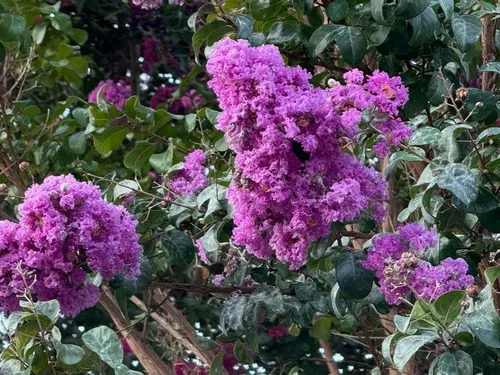Note: this is a rerun of an article originally printed in the Contra Costa Times.
Q: I have a crape myrtle and every year it is covered in a whitish powder. I have been told it is powdery mildew, but I don't know how to control it.
A: Powdery mildew is a plant disease caused by a fungus, Erysiphe lagerstroemiae. It is evidenced by white fuzz on leaves and shoots. Often the leaves are stunted and distorted. Although usually not fatal to the plant, it can cause dwarfing of new growth and death of foliage.
Crape myrtles need plenty of sun and air circulation to help fight this disease. The spores and mycelia of powdery mildew are sensitive to extremes of heat and sunlight. Counter-intuitively, rain does not increase the likelihood of powdery mildew, as the spores do not thrive in water.
Prevention is the Best Cure
The most effective way to control powdery mildew is to prevent it. Place crape myrtle trees in full sun, with enough space around them so they are not crowded.
Also, select cultivars of Lagerstroemia that are resistant to powdery mildew. Many resistant varieties have Native American nation names, such as "Catawba" (purple flowers, 15' x 15'), "Cheyenne" (red flowers, 10' x 10'), or "Natchez" (white flowers, 20' x 20').
Less Toxic Controls
There are less toxic fungicides available such as horticultural oils, neem oil, jojoba oil, sulfur, potassium bicarbonate, and biological fungicides. Except for the oils, these materials are primarily preventive. Preventive treatments are applied to susceptible plants prior to any sign of the disease while eradicants can help manage an infection after it has started. Oils work best as eradicants but have some preventive activity. Potassium bicarbonate is only available to licensed applicators.
Treatment Precautions
Never apply oils to water-stressed plants or when the temperature is higher than 90° F. Never apply oils within two weeks of an application of sulfur and never apply sulfur within two weeks of applying an oil. Sulfur has been used to manage powdery mildew for centuries but is effective mainly as a preventive. Of the sulfur products, wettable sulfur formulated with a surfactant is the simplest and most effective for the home gardener.
Biological fungicides are available commercially. These products are usually a beneficial bacterium that can destroy fungal pathogens. They are mainly used as a preventive, although they may kill the mildew they contact.
It’s essential to follow the directions on pesticide labels. Follow the fungicide directions exactly and thoroughly dowse the plant with it. It may be necessary to repeat applications every 7 - 10 days, since the plant will grow and develop new shoots and leaves that are unprotected.
Best Practices
Many people fight powdery mildew by trimming back all the affected branches, but this can reduce a floral display if done too late in the season. Remember, the best practice is to choose a resistant variety of crape myrtle, and plant it in the sun!
The next best practice is to spray with a preventive fungicide early on. But starting now, a thorough dowsing with a horticultural or plant-based oil spray will help reduce a light to moderate case of this fungal disease.
For More Information:
The University of California has additional information on managing powdery mildew on ornamentals at:
https://ipm.ucanr.edu/home-and-landscape/powdery-mildew-on-ornamentals/pest-notes/#gsc.tab=0
Information on general care and pest management for Crape Myrtles can be obtained at:
https://ipm.ucanr.edu/PMG/GARDEN/PLANTS/crapemyrtle.html

Help Desk of the UC Master Gardeners of Contra Costa County (Molly Weden)

